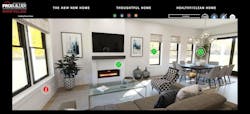How to Build a Better Healthy Home for Your Buyers
If you’d like to capture your market by literally helping your buyers to breathe easier, you may want to explore the Healthy/Clean Home of Professional Builder’s 2021 Show Village.
Based on Denver-based Thrive Home Builders’ Ultimate Z.E.N. Home (a demonstration home in collaboration with Professional Builder and the Energy and Environmental Building Alliance), the Healthy/Clean Home combines an appealing Craftsman elevation with multiple strategies for delivering fresh, healthful air throughout the 2,378-square-foot house.
“We’re building on a foundation we’ve built for many years, starting with solar and energy efficiency, the [U.S.] Department of Energy’s zero-energy-ready program, together with the EPA’s Indoor airPLUS” program, Thrive COO Stephen Myers explains. Indoor air quality “is more relevant today than it’s ever been … and we want to make sure that the air quality is as good as it can be for the occupants of that home.”
RELATED: What is a Healthy Home?
How do you build a healthy home?
According to Myers, the EPA’s Indoor airPLUS program has provided a critical framework for delivering the high levels of indoor air quality that the builder decided it wanted to achieve with its homes. “It really helps put the processes and disciplines in place for figuring out the right building techniques and training your workforce … and your trade base to do these things correctly,” Myers says.
Based on the Healthy/Clean Home, here is what Myers recommends to other builders who want to improve the air quality in their new homes.
-
Practice “source control.” One of the core principles of the EPA’s program, this concentrates on “trying to keep harmful contaminants out of the house in the first place,” says Nick Hurst of the EPA. The program recommends choosing low-emitting materials when selecting building products such as paints, cabinets, and carpets. Source control also includes managing excess moisture and handling radon.
- Ventilate the home and filter the air. The Healthy/Clean Home uses Broan Nu-Tone whole house ventilation system, including a whole house vacuum, monitoring sensors, and an energy recovery ventilator to bring fresh air into the house and high-efficiency filtration, with an optional HEPA upgrade, to capture dust, pollen, and other allergens, including the ash from forest fires. Thrive also includes activated charcoal filtration in the home to eliminate any lung-damaging ozone that might enter the home. “We can’t rely on fresh air fixing that problem,” Myers says.
- Mitigate radon. Radon, a naturally occurring radioactive gas that emerges from uranium in soil, typically enters homes through the foundation. The gas, which can cause lung cancer, is common in Colorado; half of the state’s homes have radon levels higher than the EPA’s recommended limits. Myers says that builders sometimes leave it to buyers to deal with mitigating any radon that might enter their home, but that Thrive wanted to do more for its customers. The builder includes an active radon ventilation system as a standard feature on its homes, and the Healthy/Clean Home has one too.
- Go all-electric. Thrive, which has extensive experience building energy efficient homes that rely on solar, opted to fully electrify the Healthy/Clean Home as well. The kitchen features an electric Whirlpool range. An electric Mitsubishi heat pump provides heating and cooling to the house; the system doesn’t even have a gas backup, according to Myers. The builder even went electric for the living room’s fireplace, providing the cozy ambiance that buyers expected, but without the contaminants that gas brings.
To take an immersive virtual tour of the 2021 Show Village, please visit www.pbshowvillage.com.
